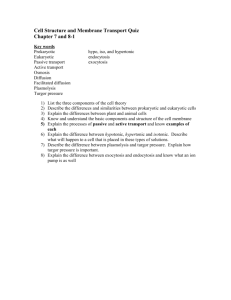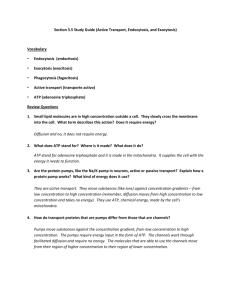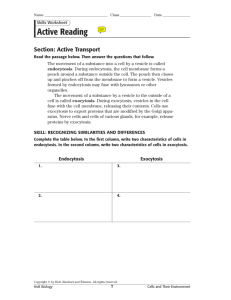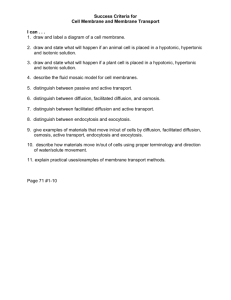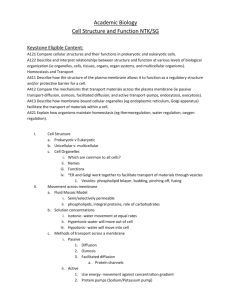Transport Across Membranes
advertisement
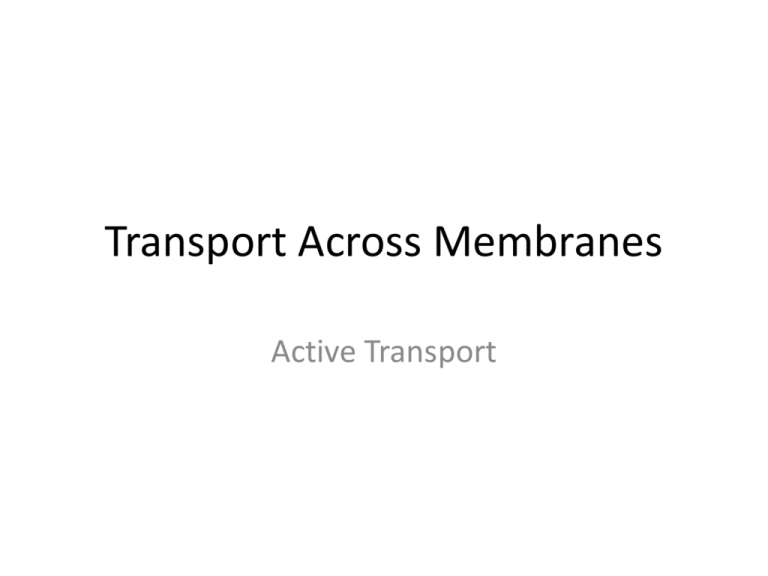
Transport Across Membranes Active Transport Active Transport Learning Objectives • Describe and explain what ids meant by active transport, endocytosis and exocytosis Success Criteria • Define active transport, endocytosis and exocytosis (Grade D-E) • Explain what is meant by active transport, endocytosis and exocytosis (Grade c) • Explain, with examples uses of endocytosis and exocytosis (Grade A-B) Active Transport Active transport is different from diffusion and facilitated diffusion because it uses ENERGY. Unlike diffusion and facilitated diffusion, molecules move AGAINST a concentration gradient. This happens in the intestines, where the concentration of nutrients is very high in the cells already. This process requires the expenditure of energy in the form of .ATP (adenosine triphosphate), a molecule produced by respiration in mitochondria and uses carrier proteins Active Transport OUTSIDE ATP INSIDE 1. Molecule attaches to carrier protein. 2. ATP molecule provides energy to go against gradient. 3. Carrier changes shape and molecule is released on the other side (side with higher concentration). Examples of active transport Active transport is used in many processes, such as the: uptake of glucose and amino acids in the small intestine absorption of mineral ions by plant roots excretion of hydrogen ions and urea by kidneys exchange of sodium and potassium ions in neurons and muscle cells. Cells that undertake active transport on a large scale have many mitochondria. 5 of 33 © Boardworks Ltd 2008 Cells like epithelial cells in the intestine have to carry out active transport. They’re packed with mitochondria to provide the ATP (energy) needed for transporting nutrients against a concentration gradient. Active transport With diagrams – explain active transport • Task • With diagrams – explain active transport • Produce a table to compare active transport and passive transport (page 24/25 may help) Summary • Complete a table to show similarities and differences between the different methods of movement across a cell membrane Simple diffusion Energy required? Substances moving Location of cell membrane Factors affecting speed Facilitated diffusion Active transport Osmosis What is bulk transport? – Use worksheet When extremely large substances need to be moved across a cell membrane, bulk transport is used. The two types of bulk transport are endocytosis and exocytosis, and they involve changes to the membrane shape. Endocytosis is the bulk transport of material in to the cell, and can be split into three processes: phagocytosis, pinocytosis and receptor-mediated endocytosis. Exocytosis is the bulk transport of material out of the cell – essentially the reverse of endocytosis. 10 of 33 © Boardworks Ltd 2008 Mechanisms of endocytosis Exocytosis • http://www.youtube.com/watch?v=HndmASfmI8Y • Exocytosis in paramecium http://www.youtube.com/watch?v=U9pvm_4-bHg • Phagocytosis! – amoeba and paramecium • http://www.youtube.com/watch?v=aWItglvTiLc Both http://www.youtube.com/watch?v=bFRoZpIAuyk Complete exam question June 11 Qu 2 Comparing methods of transport What’s the keyword? Multiple-choice quiz Homework • Complete exam booklet – next Wednesday!!

